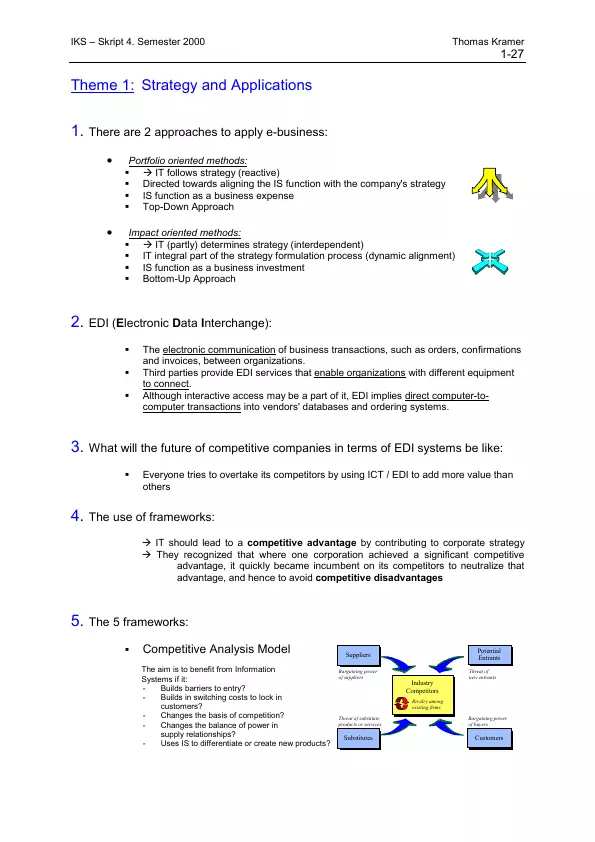Theme 1: Strategy and Applications
1. There are 2 approaches to apply e-business:
• Portfolio oriented methods:
--> IT follows strategy (reactive)
- Directed towards aligning the IS function with the company's strategy
- IS function as a business expense
- Top-Down Approach
• Impact oriented methods:
--> IT (partly) determines strategy (interdependent)
- IT integral part of the strategy formulation process (dynamic alignment)
- IS function as a business investment
- Bottom-Up Approach
[...]
Inhaltsverzeichnis (Table of Contents)
- Theme 1: Strategy and Applications
- There are 2 approaches to apply e-business:
- Portfolio oriented methods
- Impact oriented methods
- EDI (Electronic Data Interchange)
- What will the future of competitive companies in terms of EDI systems be like
- The use of frameworks
- The 5 frameworks:
- Competitive Analysis Model
- Value Chain Analysis (Example: Cisco Systems)
- Customer Life Cycle (Example: MSN Home Advisor)
- Generic Strategies
- Reference Models: 'Embrace and Extend'
- The IT advantage?
- Critics on the frameworks
- There are 2 approaches to apply e-business:
- Theme 2: Business Models
- Examples for e-commerce relationships
- Type of business models
Zielsetzung und Themenschwerpunkte (Objectives and Key Themes)
The text explores the strategic use of information systems (IS) in business, analyzing frameworks for achieving competitive advantage through IT-driven strategies. It examines different approaches to applying e-business, exploring the role of Electronic Data Interchange (EDI) and the impact of IT on industry structure and competitive dynamics. Additionally, the text delves into various business models for e-commerce, highlighting the evolution of online relationships and the different types of e-business models.
- Strategic use of IS for competitive advantage
- Impact of IT on industry structure and competitive dynamics
- Frameworks for analyzing the use of IS in business
- Evolution of e-business models and relationships
- Different types of e-commerce models
Zusammenfassung der Kapitel (Chapter Summaries)
The first chapter examines two approaches to applying e-business: portfolio-oriented methods, which focus on aligning IS with company strategy, and impact-oriented methods, which view IT as an integral part of strategy formulation. It also introduces EDI and its implications for competitive advantage. The subsequent chapters delve into frameworks for analyzing the use of IS in business, such as Porter's Five Forces and Value Chain Analysis, along with their implications for achieving cost leadership, differentiation, and innovation. The text also explores the concept of "second-mover advantage" and the challenges of achieving sustainable competitive advantage through IT.
Schlüsselwörter (Keywords)
The text revolves around the strategic use of information systems, competitive advantage, e-business models, Electronic Data Interchange (EDI), Porter's Five Forces, Value Chain Analysis, and different types of business models such as information products, aggregators, auctions, and exchanges. It explores the interplay between IT, business strategy, and industry structure, highlighting the implications for achieving competitive advantage and the challenges of sustainability in the digital age.
- Citation du texte
- Thomas Kramer (Auteur), 2000, eBusiness: Strategies, Frameworks, Business Models, Networking, Security, ePayment, eProcurement, SCM, ERP, CRM, Case Study: Channel Conflicts, Munich, GRIN Verlag, https://www.grin.com/document/1922



